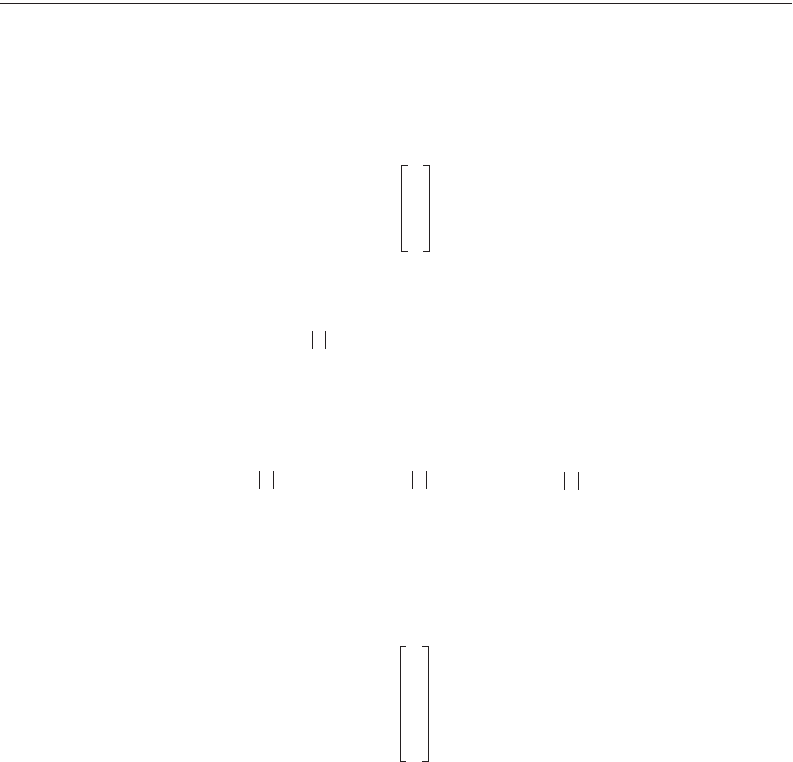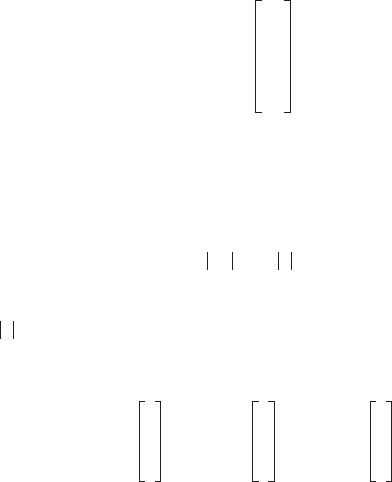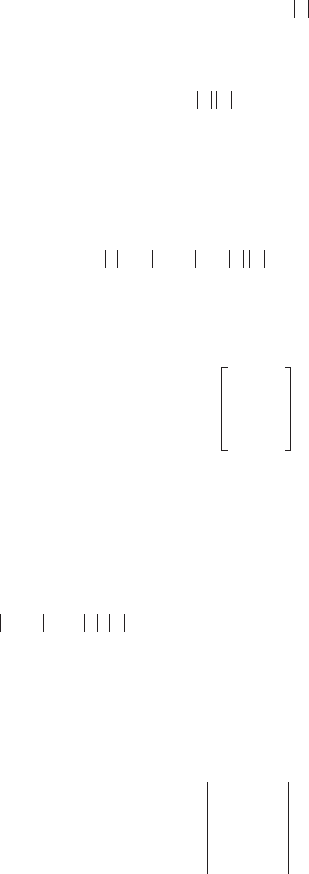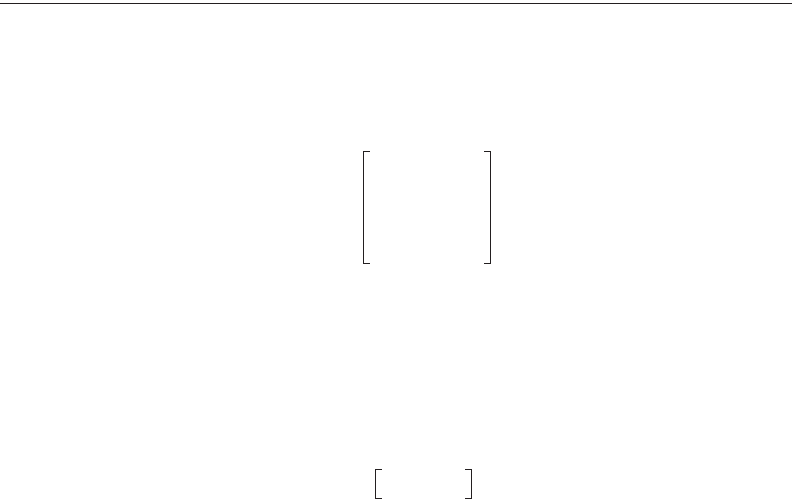Wai-Fah Chen.The Civil Engineering Handbook
Подождите немного. Документ загружается.


53-12 The Civil Engineering Handbook, Second Edition
(53.54)
For vector representation of a straight line, see “Planes and Lines” in the following section.
Equation of a Sphere
If (X
c
, Y
c
, Z
c
) represents the center of the sphere and R is its radius, its equation is given by
(53.55)
53.4 Vector Algebra
Definitions
A vector is an entity which has a magnitude and direction. In two- and three-dimensional spaces, it is a
directed line segment from one point to another. The projections of the vector on the x
1
, x
2
, and x
3
axes
are a
1
, a
2
, and a
3
and are called the vector components. It is represented by a column:
The length of the vector is designated by |a| and is given by
(53.56)
A vector’s direction is given either by the angles a, b, g it makes with the axes or by their cosines. The
latter are called direction cosines and are given by
(53.57)
It is evident that
(53.58)
Generalizing a vector to n dimensions, we write
Vector Operations
Equality.
XX
1
–
X
2
X
1
–
--------------
YY
1
–
Y
2
Y
1
–
-------------
ZZ
1
–
Z
2
Z
1
–
-------------
==
XX
c
–()
2
YY
c
–()
2
ZZ
c
–()
2
++ R
2
=
a
a
1
a
2
a
3
=
a a
1
2
a
2
2
a
3
2
++()
12§
=
a
cos
a
1
a
-----
b
cos
a
2
a
-----
g
cos
a
3
a
-----===
ab
2
cos+
2
g
2
cos+cos 1=
a
a
1
a
2
M
a
n
=
ab when a
1
b
1
a
2
, b
2
L a
n
,, b
n
====
© 2003 by CRC Press LLC

General Mathematical and Physical Concepts 53-13
Addition/Subtraction.
Multiplication by a Scalar. A scalar is a quantity which has magnitude but no direction, such as mass,
temperature, time, etc., and will be designated by a lowercase Greek letter.
(53.59)
Any vector a is reduced to a unit vector a˚ when dividing its components by its length, which is a
scalar, or . The components of a˚ are the direction cosines of a. Unit vectors along the
coordinate axes are called base or basis vectors and are given by
(53.60)
Any vector in 3-space is uniquely expressed as
(53.61)
The right-handed system introduced in Section 53.1 can be generalized for three vectors a, b, c. If they
are not coplanar, and they have the same initial point, then they are said to form a right-handed system
if a right-threaded screw rotated through an angle less than 180˚ from a to b would advance in the
direction c.
Vector Products
Dot (or Scalar) Product.
(53.62)
This is also called the inner product. It is a scalar and has the following properties:
cab or c
1
± a
1
b
1
c
2
,± a
2
b
2
L c
n
,,± a
n
b
n
±====
ab+ ba+=
ab+()c + abc+()+=
l
a
l
a
1
l
a
2
M
l
a
n
=
lm
a()
lm
()a
ml
a()==
lm
+()a
l
a
m
a+=
l
ab+()
l
a
l
b+=
l
a
l
a=
a
∞
aa§=
i
1
0
0
j
0
1
0
k
0
0
1
== =
a a
1
i a
2
j a
3
k++=
ab◊◊
◊◊
a
p
b
p
p 1=
n
Â
a
1
b
1
a
2
b
2
L a
n
b
n
+++==
© 2003 by CRC Press LLC

53-14 The Civil Engineering Handbook, Second Edition
(53.63)
The dot product of a vector with itself is equal to the square of its length, or
(53.64)
If q is the angle between two vectors a and b (in two- or three-dimensional space), it can be shown that
(53.65)
It follows that if a is perpendicular to b, then
Cross (or Vector) Product. (read “a cross b”) is another vector c, which is perpendicular to both
a and b and in a direction such that a, b, c (in this order) form a right-handed system. The length of c
is given by
(53.66)
where q is the angle between a and b. This quantity is the area of the parallelogram determined by a and
b. If , and , then c is given by the determinant
(53.67)
It has the following properties
(53.68)
For two nonzero vectors, if , then a and b are parallel.
Scalar Triple Product.
(53.69)
is a scalar which is equal to the volume of the parallelepiped determined by a, b, c. If it is zero, then the
three vectors are coplanar. It has the following properties:
ab◊◊
◊◊
ba◊◊
◊◊
=
abc+()◊◊
◊◊
ab ac◊◊
◊◊
+◊◊
◊◊
=
l
ab◊◊
◊◊
()
l
a()b◊ a
l
b()◊ ab◊◊
◊◊
()
l
===
ii◊◊
◊◊
jj◊◊
◊◊
kk◊◊
◊◊
1== =
ij◊◊
◊◊
jk◊◊
◊◊
ki◊◊
◊◊
0===
aa◊ a
1
2
a
1
2
L a
n
2
++ a
2
==
ab◊◊
◊◊
ab
q
cos=
ab◊◊
◊◊
0.=
ab¥¥
¥¥
cab¥¥
¥¥
ab
q
sin==
a a
1
i a
2
j a
3
k++= b b
1
i b
2
j b
3
k++=
cab¥¥
¥¥
ijk
a
1
a
2
a
3
b
1
b
2
b
3
==
ab¥¥
¥¥
ba¥¥
¥¥
()–=
abc+()¥¥
¥¥
abac¥¥
¥¥
(observing the order)+¥¥
¥¥
=
aac¥¥
¥¥
()◊◊
◊◊
0=
ab¥¥
¥¥
2
a
2
b
2
ab◊◊
◊◊
()
2
–=
ii¥¥
¥¥
jj¥¥
¥¥
kk¥¥
¥¥
0== =
ij¥¥
¥¥
kj k¥¥
¥¥
; ik i¥¥
¥¥
; j===
ab¥¥
¥¥
0=
abc◊◊
◊◊
¥¥
¥¥
a
1
a
2
a
3
b
1
b
2
b
3
c
1
c
2
c
3
=
abc◊◊
◊◊
¥¥
¥¥
bca◊◊
◊◊
¥¥
¥¥
cab
abc◊◊
◊◊
¥¥
¥¥
◊◊
◊◊
¥¥
¥¥
ab c¥¥
¥¥
◊◊
◊◊
==
=
© 2003 by CRC Press LLC

General Mathematical and Physical Concepts 53-15
Planes and Lines
If p
0
is a given point in a plane, n is a nonzero vector normal to the plane, and p is any point in the
plane, then the equation of the plane takes the form
(53.70)
Let n = Ai + Bj + Ck, p
0
= X
0
i + Y
0
j + Z
0
k, and p = Xi + Yj + Zk. Then Eq. (53.70) becomes
(53.71)
or
where D = – (AX
0
+ BY
0
+ CZ
0
). Two planes are parallel when they have a common normal vector n, and are
perpendicular when their normals are, or n
1
· n
2
= 0.
If p
0
represents a given point on a line, p any other point on the line, and v is a given nonzero vector
parallel to the line, then
(53.72)
is an equation of the line. In component form, it yields three scalar equations describing the parametric
form (l is the running parameter):
(53.73)
If l is eliminated, one gets the usual two-equation form of a straight line in space; see Eq. (53.54).
53.5 Matrix Algebra
Definition
A matrix is a group of numbers or scalar functions collected in two-dimensional (rectangular) array.
A matrix is designated by a boldface capital Roman letter. Thus, an m ¥ n matrix can be symbolically
written as
Types of Matrices
Square Matrix. This is a matrix in which the number of rows equals the number of columns. In this
case,
m,
A
m
is a square matrix of order m. The principal (or main) diagonal of a square matrix is composed
of all elements a
ij
for which i = j.
Row Matrix.
pp
0
–()n◊◊
◊◊
0orpn p
0
n◊◊
◊◊
–◊◊
◊◊
0==
AX X
0
–()BY Y
0
–()CZ Z
0
–()++ 0=
AX BY CZ D+++ 0=
pp
0
l
v+=
XX
0
l
v
x
+=
YY
0
l
v
y
+=
ZZ
0
l
v
z
+=
A
mn,
a
11
a
12
L a
1n
a
21
a
22
a
2n
M OM
a
m1
a
m2
L a
mn
=
a
1 n,
a
1
a
2
L a
n
=
© 2003 by CRC Press LLC

53-16 The Civil Engineering Handbook, Second Edition
Column Matrix or Vector.
Diagonal Matrix.
That is, d
ij
= 0 for all i π j.
Scalar Matrix.
Identity or Unit Matrix.
Null Matrix. A null or zero matrix is a matrix whose elements are all zero. It is denoted by a boldface
zero, 0.
Upper Triangular Matrix.
with u
ij
= 0 for i > j.
b
m 1,
b
1
b
2
M
b
m
=
D
d
11
0 L 0
0 d
22
0
M OM
00L d
mm
=
A
a 0 L 0
0 a 0
M O M
00 L a
=
a
ij
0 for all ij
a
ij
a for all ij==
π=
I
10L 0
01 0
M OM
00L 1
=
a
ij
0 for all ij
a
ij
1 for all ij==
π=
U
u
11
u
12
L u
1m
0 u
22
u
2m
M OM
00L u
mm
=
© 2003 by CRC Press LLC

General Mathematical and Physical Concepts 53-17
Lower Triangular Matrix.
where l
ij
= 0 for i > j.
Basic Matrix Operations
Two matrices A and B are equal if they are of the same dimensions and each element a
ij
= b
ij
for all i
and j. The sum of two matrices A and B is possible only if they are of equal dimensions, and the elements
of the resulting matrix C are c
ij
= a
ij
+ b
ij
for all i, j. The following relations apply to addition (and
subtraction) of matrices:
(53.74)
with 0 being the zero or null matrix, and –A is the matrix composed of –a
ij
as elements.
Multiplication of a matrix by a scalar a results in another B = aA whose elements are b
ij
= aa
ij
for all
i and j.
The following relations hold for scalar multiplication (l, m are scalars):
(53.75)
The product of two matrices is another matrix. The two matrices must be conformable for multiplica-
tion, i.e., the number of columns of the first matrix must equal the number of rows of the second matrix.
Thus, if A is an m ¥ q matrix and B is a q ¥ n matrix, the product AB, in that order, is another matrix C
with m rows (as in A) and n columns (as in B). Each element c
ij
in C is obtained by multiplying each
one of the q elements in the ith row in A by the corresponding element in the jth column in B and
adding. Algebraically, this is written as
(53.76)
To illustrate matrix multiplication:
Matrix multiplication is not commutative; that is, in general FG π GF, even if the dimensions of the
matrices allow multiplication in both directions (e.g., m ¥ n and n ¥ m, or square matrices). The following
relationships regarding matrix multiplication hold:
L
l
11
0 L 0
l
21
l
22
0
M OM
l
m1
l
m2
L l
mm
=
AB+ BA+=
ABC+()+ AB+()C+ ABC++==
AA–()+ 0=
l
AB+()
l
A
l
B+=
lm
+()A
l
A
m
A+=
l
AB()
l
A()B+ A
l
B()=
lm
A()
lm
()A=
c
ij
a
il
b
1j
a
i2
b
2j
º
a
iq
b
qj
+++ a
ik
b
kj
k 1=
q
Â
==
C
21,
A
23,
B
31,
102
210
1
5
3
==
11¥()05¥()23¥()++
21¥()15¥()03¥()++
7
7
==
© 2003 by CRC Press LLC
53-18 The Civil Engineering Handbook, Second Edition
(53.77)
AB = 0 is possible without either A or B equaling 0. Also, AB = AC does not imply B = C.
The transpose of the m ¥ n matrix A is an n ¥ m matrix formed from A by interchanging rows and
columns such that the ith row of A becomes the ith column of the transposed matrix. We denote the
transpose of A by A
T
. If B = A
T
, it follows that b
ij
= a
ji
for all i and j. The following relationships apply
to the transpose of a matrix:
(53.78)
A square matrix A is symmetric if A
T
= A. Diagonal, scalar, and identity matrices are symmetric, since each
is equal to its transpose. For any matrix A (not necessarily square), both AA
T
and A
T
A are symmetric. If B is
a symmetric matrix of suitable dimensions, then for any matrix A, both ABA
T
and A
T
BA are also symmetric.
If a is a column matrix (or vector), then a
T
a is a positive scalar which is equal to the sum of the squares
of its elements; for example, the square of the vector’s length.
A square matrix A is skew-symmetric if A
T
= –A and a
ij
= –a
ji
for all i,j. For any square matrix A, the
matrix (A + A
T
) is symmetric and (A – A
T
) is skew-symmetric.
The trace of a square matrix is the scalar which is equal to the sum of its main diagonal elements.
It is denoted by tr (A); thus tr (A)
n,n
= a
11
+ a
22
+ L a
nn
. The following are properties of the trace:
(53.79)
Matrix Inverse
Division of matrices is not defined. Instead, the inverse of a square matrix A, if it exists, is the unique
matrix A
–1
with the following property:
(53.80)
where I is the identity matrix.
The properties of the inverse are
(53.81)
AI IA A in which I is the unit or identity matrix==
AB BAπ
ABC() AB()CABC (associative law)==
AB C+()AB AC (distributive laws)+=
AB+()CACBC (distributive laws)+=
AB+()
T
A
T
B
T
+=
AB()
T
B
T
A
T
note reverse order()=
a
A()
T
a
A
T
=
A
T
()
T
A=
tr A() tr A
T
()=
tr
l
A()
l
tr A
T
()=
tr AB+()tr A() tr B()+=
tr AB()tr BA()=
tr FAF
1–
()tr A() F( nonsingular matrix)=
AA
1–
A
1–
AI==
AB()
1–
B
1–
A
1–
(note reverse order)=
A
1–
()
1–
A=
A
T
()
1–
A
1–
()
T
=
l
A()
1–
1
l
---
A
1–
=
© 2003 by CRC Press LLC

General Mathematical and Physical Concepts 53-19
A square matrix which has an inverse is called nonsingular, whereas a matrix which does not have an
inverse is called singular.
It was stated previously that AB can equal 0 without either A = 0 or B = 0. If, however, either A or B
is nonsingular, then the other matrix must be a null matrix. Hence, the product of two nonsingular
matrices cannot be a null or zero matrix.
Associated with each square matrix A is a unique scalar called the determinant of A. It is denoted either
by det A or by |A|. Thus, for
the determinant is expressed as
The determinant of order n (for an n ¥ n square matrix) can be defined in terms of determinants of
order n – 1 and less. The determinant of a 1 ¥ 1 matrix is defined as the value of that one element, i.e.,
for A = [a
11
], |A| = det A = a
11
.
If A is an n • n matrix, and one row and one column of A are deleted, the resulting matrix is an
(n – 1) ¥ (n – 1) submatrix of A. The determinant of such a submatrix is called a minor of A, and it is
designated by m
ij
, where i and j correspond to the deleted row and column, respectively. More specifically,
m
ij
is known as the minor of the element a
ij
in A. Thus, each element of A has a minor.
The cofactor c
ij
of an element a
ij
is defined as
(53.82)
The determinant of an n ¥ n matrix A can now be defined as
(53.83)
which states that the determinant of A is the sum of the products of the elements of the first row of
A and their corresponding cofactors. (It is equally possible to define |A| in terms of any other row or
column, but for simplicity we used the first row.) On the basis of this definition, the 2 ¥ 2 matrix
has cofactors c
11
= |a
22
| = a
22
and c
12
= –|a
21
| = –a
21
, and the determinant of A is
The cofactor matrix C of a matrix A is the square matrix of the same order as A in which each element
a
ij
is replaced by its cofactor c
ij
.
The adjoint matrix of A, denoted by adj A, is the transpose of its cofactor matrix, i.e.,
(53.84)
It can be shown that
(53.85)
A
31
12
=
A
3 1
1 2
=
c
ij
1–()
ij+
m
ij
=
A a
11
c
11
a
12
c
12
L
a
1n
c
1n
+++=
A
a
11
a
12
a
21
a
22
=
A a
11
c
11
a
12
c
12
+ a
11
a
22
a
12
a
21
–==
adj AC
T
=
A adj A()adj A()AAI==
© 2003 by CRC Press LLC

53-20 The Civil Engineering Handbook, Second Edition
Comparison of Eqs. (53.80) and (53.85) leads directly to a procedure for evaluating the inverse from
the adjoint matrix, namely,
(53.86)
It is easy to show that for a 2 ¥ 2 matrix, the adjoint matrix is simply
A square matrix is called orthogonal if its inverse is equal to its transpose, or A
–1
= A
T
. Thus, a matrix M
is orthogonal when
(53.87)
The columns of an orthogonal matrix are mutually orthogonal vectors of unit length. Also,
(53.88)
when |M| = +1, M is called “proper orthogonal”; otherwise it is termed “improper orthogonal.” The
product of two orthogonal matrices is also an orthogonal matrix.
Matrix Inverse by Partitioning
Let A be an n ¥ n square nonsingular matrix whose inverse is to be evaluated. We partition A in the form
s
m
where A
11
is s ¥ s, A
12
is s ¥ m, A
21
is m ¥ s, A
22
is m ¥ m, and m + s = n. The inverse A
–1
exists, and we
shall denote it, in the correspondingly partitioned form, by
From the basic definition of an inverse we have AA
–1
= AB = I, or in the partitioned form,
which, when multiplied out, leads to four matrix equations in the four B
ij
submatrices as unknowns, the
solution of which, when A
–1
11
exists, is given by
(53.89)
A
1–
adj A
A
------------=
a
22
a
12
–
a
21
– a
11
M
T
MMM
T
I==
M 1±=
A
A
11
A
12
A
21
A
22
s
m
=
A
1–
B
B
11
B
12
B
21
B
22
==
A
11
A
12
A
21
A
22
B
11
B
12
B
21
B
22
I
s
0
0I
m
=
B
11
A
11
1–
A
11
1–
A–
12
B
21
=
B
12
A
11
1–
A–
12
B
22
=
B
21
B
22
A–
21
A
11
1–
=
B
22
A
22
A–
21
A
11
1–
A
12
()
1–
=
© 2003 by CRC Press LLC

General Mathematical and Physical Concepts 53-21
Alternatively, when A
–1
22
exists, the solution is
(53.90)
If A is originally a symmetric matrix, then A
21
= A
T
12
correspondingly B
21
= B
T
21
.
The rank of a matrix is the order of the largest nonzero determinant that can be formed from the
elements of the matrix by appropriate deletion of rows or columns (or both). Thus, a matrix is said to
be of rank m if and only if it has at least one nonsingular submatrix of order m, but has no nonsingular
submatrix of order more than m. A nonsingular matrix of order n has a rank n. A matrix with zero rank
has elements that must all be zero.
The inverse A
–1
is defined only for square matrices, and it exists when the rank of A is equal to its
order. A more general inverse may be defined for rectangular matrices with arbitrary rank. It is called
the generalized inverse, denoted by A
–
, and satisfies the relation
(53.91)
This condition is not sufficient to define a unique A
–
. Additional conditions may be imposed on A
–
,
such as
(53.92)
If we impose all four conditions in Eqs. (53.91) and (53.92), the inverse is called the pseudo inverse or the
Moore–Penrose inverse, and is denoted by A
+
.
The Eigenvalue Problem
For a square matrix A of order n, we seek a nonzero vector x and a scalar l such that
(53.93)
which is called the “eigenvalue problem.” A solution l
0
and x
0
to this problem is called an eigenvalue
(proper value, characteristic value) and the corresponding eigenvector (proper vector, characteristic vec-
tor) of the matrix A. An eigenvector, if one exists, can be determined only to a scalar multiplication, for
if l
0
, x
0
satisfy Eq. (53.93), then l
0
, a x
0
, where a is an arbitrary scalar, will also.
Equation (53.93) can be rewritten as
(53.94)
which represents a set of homogenous linear equations. For a nontrivial solution to this set the following
condition must be satisfied:
(53.95)
Equation (53.95) represents a real polynomial equation of degree n:
(53.96)
B
11
A
11
A
12
A
22
1–
A
21
–[]
1–
=
B
12
B–
11
A
12
A
22
1–
=
B
21
A–
22
1–
A
21
B
11
=
B
22
A
22
1–
A
22
1–
A
21
B
12
–=
AA
–
AA=
A
–
AA
–
A
–
=
AA
–
()
T
AA
–
=
( A
–
A)
T
A
–
A=
Ax
l
x=
A
l
I–()x 0=
A
l
I– 0=
b
n
l
–()
n
b
n 1–
l
–()
n 1–
L b
0
+++0=
© 2003 by CRC Press LLC
